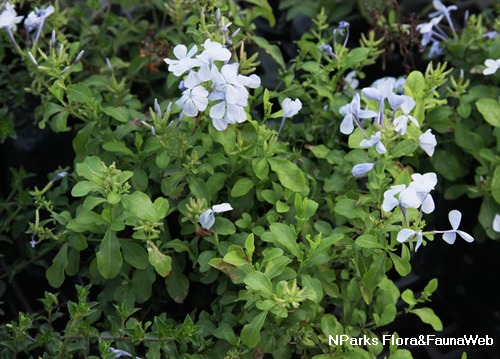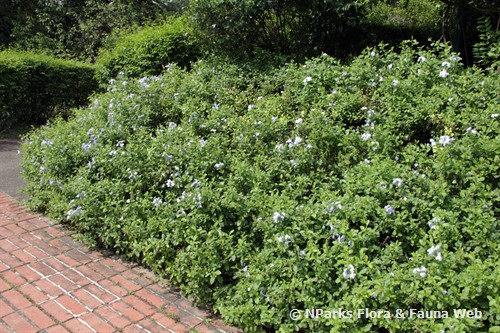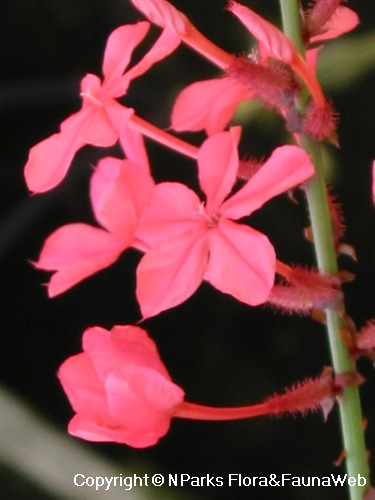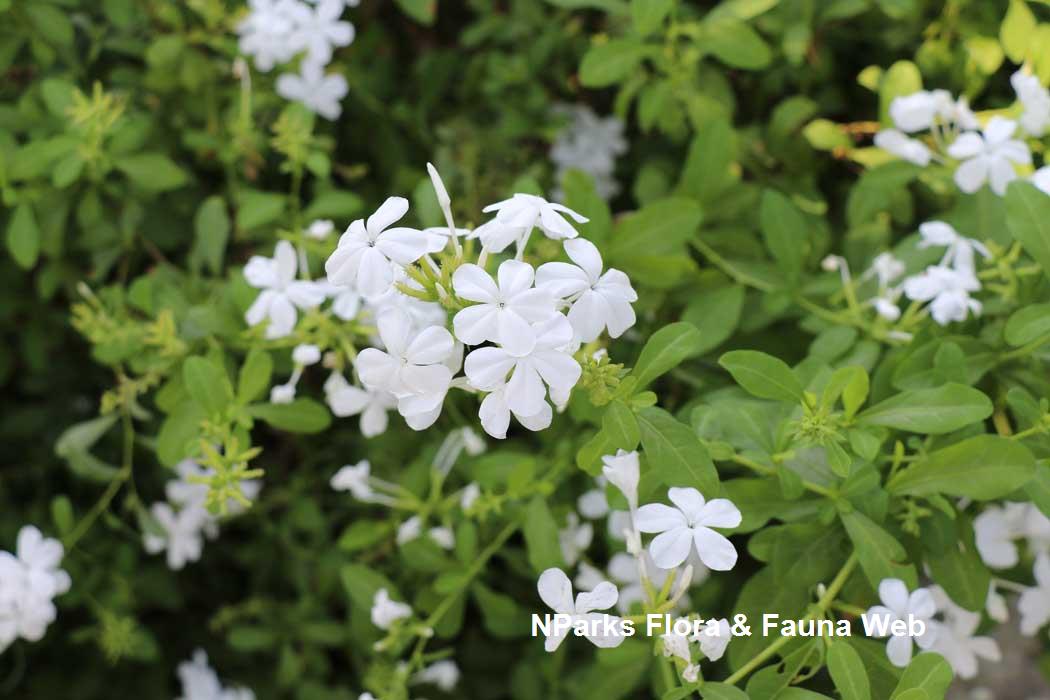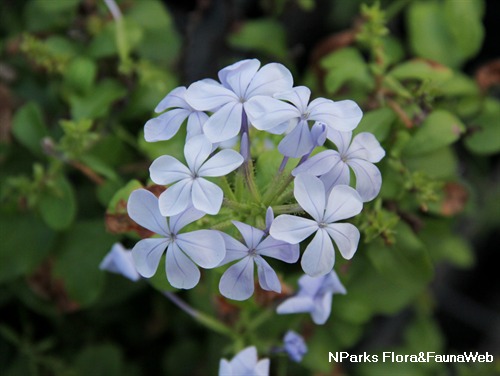
Back
Plumbago auriculata Lam.
| Family Name: | Plumbaginaceae |
| Synonyms: | Plumbago capensis |
| Common Name: | Cape Leadwort, Cheraka, Cape Plumbago, Forget-Me-Not |
Plumbago auriculata, also known as Cape Leadwort is a native to South Africa. This shrub features clusters of pale-blue flowers that blooms all year round. It can be grown in container planting, or in masses as hedges.
Name
Classifications and Characteristics
| Plant Division | Angiosperms (Flowering Seed Plants) (Dicotyledon) |
|---|---|
| Plant Growth Form | Shrub |
| Lifespan (in Singapore) | Perennial |
| Mode of Nutrition | Autotrophic |
| Maximum Height | 1 m |
| Maximum Plant Spread / Crown Width | 1 m |
Biogeography
| Native Distribution | Cape Province of South Africa |
|---|---|
| Native Habitat | Terrestrial |
| Preferred Climate Zone | Tropical |
| Local Conservation Status | Non-native (Horticultural / Cultivated Only) |
Description and Ethnobotany
| Growth Form | Scrambling shrub, able to grow to about 1 - 1.5 m tall and with a spread of 1 m wide.<1> |
|---|---|
| Foliage | Leaves are obovate with crenulate margins, 15 to 50 mm long, thin and light green in colour. The leaf axils are winged with ear-shaped appendages at the base of each leaf (see etymology). Another salient feature is the abundant axillary growth of leaves, resulting in many leaves of varying sizes being found all over the plant, and a distinctively dense and bushy appearance even in small plants. |
| Flowers | Flowers are pale blue, borne on rounded terminal clusters. Flowering continues throughout the year in Singapore; but only from summer through autumn in sub-tropical and warm temperate climates. |
| Habitat | Found in thickets and disturbed sites. |
| Etymology | Genus epithet 'Plumbago' derived from the Latin "plumbum" meaning "lead" (the metallic element). Named after a European species which was used to cure lead poisoning. Species epithet 'auriculata' from the Latin "auricula" meaning "ear", after the appendages at the base of each leaf which were deemed to be ear-shaped. |
Landscaping Features
| Landscaping | Known to be a scandent (semi-climbing) shrub in Mediterranean climates where it originates, but most often seen in the Singapore landscape as free-standing shrub masses or groundcover. It can also be used as a low hedge but requires frequent clipping. It is easy to maintain and forms a dense mass of green leaves and pale blue flowers which appear almost fluorescent when viewed in under low light. However, the flowers do not stand up well to being drenched; they also remain on the plant after they have wilted, which may result in periodic unsightliness after flowering. Suitable for borders, as underplanting or in containers. A drought tolerant plant, it prefers a bright, sunny position and well-drained soil as it does not tolerate water-logging. |
|---|---|
| Desirable Plant Features | Ornamental Flowers |
| Landscape Uses | Parks & Gardens, Small Gardens, Container Planting |
Plant Care and Propagation
| Light Preference | Full Sun |
|---|---|
| Water Preference | Moderate Water |
| Plant Growth Rate | Moderate |
| Rootzone Tolerance | Drought Tolerant, Well-Drained Soils |
| Propagation Method | Seed, Stem Cutting |
Foliar
| Foliage Retention | Evergreen |
|---|---|
| Mature Foliage Colour(s) | Green |
| Mature Foliage Texture(s) | Smooth |
| Prominent Young Flush Colour(s) | Green |
| Young Flush Texture(s) | Smooth |
| Foliar Type | Simple / Unifoliate |
| Foliar Attachment to Stem | Sessile |
| Foliar Shape(s) | Non-Palm Foliage (Obovate, Oblanceolate, Spathulate) |
| Foliar Venation | Palmate |
| Foliar Margin | Crenulate |
| Foliar Apex - Tip | Acute, Obtuse, Mucronate |
| Foliar Base | Attenuate, Auriculate |
| Leaf Area Index (LAI) for Green Plot Ratio | 4.5 (Shrub & Groundcover - Dicot) |
Non - Foliar and Storage
| Root Type | Underground |
|---|
Floral (Angiosperm)
| Flower & Plant Sexuality | Bisexual Flowers |
| Flower Colour(s) | Blue |
|---|---|
| Flower Texture(s) | Smooth |
| Flower Grouping | Cluster / Inflorescence |
| Flower Location | Terminal |
| Flower Symmetry | Radial |
| Individual Flower Shape | Tubular |
| Inflorescence Type | Raceme |
| Flowering Period | Free-Flowering |
| Flowering Opening Time | Daytime |
| Flowering Habit | Polycarpic |
Fruit, Seed and Spore
| Mature Seed Colour(s) | Brown |
|---|
References
| References | <1> de Ruijter, A., (2006). Plumbago auriculata Lam. PROTA (Plant Resources of Tropical Africa / Resources végétales de l’Afrique tropicale), Wageningen, Netherlands. <http://www.prota4u.org/search.asp>. Accessed 19 July 2024. |
|---|
Image Repository
Others
| Master ID | 1053 |
|---|---|
| Species ID | 2346 |
| Flora Disclaimer | The information in this website has been compiled from reliable sources, such as reference works on medicinal plants. It is not a substitute for medical advice or treatment and NParks does not purport to provide any medical advice. Readers should always consult his/her physician before using or consuming a plant for medicinal purposes. |

